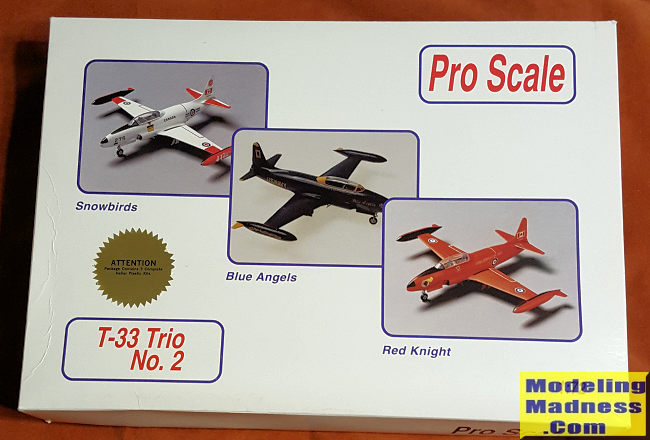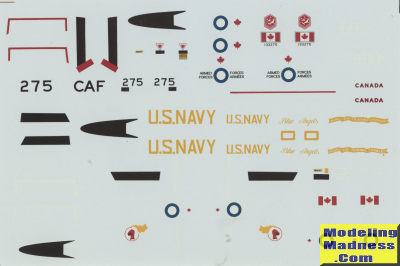
| KIT #: | PS2 |
| PRICE: | $20.00 'used' |
| DECALS: | Three options |
| REVIEWER: | Scott Van Aken |
| NOTES: | Three complete Heller kits |

| HISTORY |
The Lockheed T-33 Shooting Star is an American-built jet trainer aircraft. It was produced by Lockheed and made its first flight in 1948, piloted by Tony LeVier. The T-33 was developed from the Lockheed P-80/F-80 starting as TP-80C/TF-80C in development, then designated T-33A. It was used by the U.S. Navy initially as TO-2 then TV-2, and after 1962, T-33B. While there are no more military T-33s still in active service (Bolivia retiring theirs a few years ago), the type is very popular with the jet warbird crowd. Many T-33s spent over 40 years on active service before being retired.
| THE KIT |
 This
is a reboxing of the very nice Heller T-33 Shooting Star. In fact there are
three kits included in this box. The feature of this boxing is that all three
planes are aerial display planes. The previous boxing also has three display
birds. This one consists of a Blue Angels aircraft as well as the Red Knight and
a Snowbirds plane.
This
is a reboxing of the very nice Heller T-33 Shooting Star. In fact there are
three kits included in this box. The feature of this boxing is that all three
planes are aerial display planes. The previous boxing also has three display
birds. This one consists of a Blue Angels aircraft as well as the Red Knight and
a Snowbirds plane.
The Heller kit is a known quality and until the Platz kit arrived a few years back, was considered by most to be the best T-33A in this scale. It shows its 70s heritage with raised panel lines, but most don't care all that much about this feature and it can be rescribed by those who do.
It is basic model kit without p.e., resin or fiddly construction due to a mass of inserts. The kit has a cockpit tub with raised side panel detail and the instrument panels are the same There are a pair of one-piece bang seats without harness detail and a pair of control sticks. That is pretty much it. The nose gear well attaches to the underside of the cockpit and it is the placement of the gear well that determines how well the cockpit is situated.
There are intake splitter plates that incorporate a blanking plate that are installed before the fuselage halves are closed. Same for a two piece exhaust pipe. The kit has a separate nose to take care of the RT-33 option, though that is not required for any of the options. Note that there is no clear window for the camera windows. I guess you simply paint that gloss black. An undetermined amount of weight is required for the nose and there is room for it. One then closes the fuselage halves and attaches the nose. Or you could glue to the nose halves to each fuselage half prior to this to get a better seam fit between the two.
There is no closed in wheel well for the main gear, though there is some detail on the underside of the upper wings. The lower wing is a single piece that incorporates the bottom half of the tip tank. The top half is with the upper wing halves. Tailplanes are a single piece and simply slot in place. The canopy and windscreen are a single molding and can only be displayed closed. It is a bit on the thick side, which is fine as there is little to see on the inside. The last things to add are the landing gear and main gear doors. The nose gear doors are molded in the fuselage halves. The speed brake can be posed up or down, though there are no actuator pistons.
 The
instructions are a copy of the Heller ones though the paint color information
has been removed. You are on your own in terms of what color the cockpit or
wheels wells are. As mentioned, the three options are aerobatic planes. One is a
white Snowbirds plane with red wing and horizontal stab markings. Inside of the
tip tanks is black. Another is a blue with yellow trim plane with the Blue
Angels in 1956. Finally, the Red Knight from 1967 in gloss red. Now some of
these options have bare metal leading edges to the flight surfaces and the
painting instructions cover that. Thanks to a near-white decal sheet backing,
the white markings are pretty much impossible to show. The sheet looks OK,
though I have no idea how old this kit might be. Perhaps testing one prior to
application would be a wise move. There are a ton of aftermarket options in this
scale for this plane so you do not have to use the kit markings. I certainly
plan on using others.
The
instructions are a copy of the Heller ones though the paint color information
has been removed. You are on your own in terms of what color the cockpit or
wheels wells are. As mentioned, the three options are aerobatic planes. One is a
white Snowbirds plane with red wing and horizontal stab markings. Inside of the
tip tanks is black. Another is a blue with yellow trim plane with the Blue
Angels in 1956. Finally, the Red Knight from 1967 in gloss red. Now some of
these options have bare metal leading edges to the flight surfaces and the
painting instructions cover that. Thanks to a near-white decal sheet backing,
the white markings are pretty much impossible to show. The sheet looks OK,
though I have no idea how old this kit might be. Perhaps testing one prior to
application would be a wise move. There are a ton of aftermarket options in this
scale for this plane so you do not have to use the kit markings. I certainly
plan on using others.
| CONCLUSIONS |
This purchase was spurred by a recent article of a Hasegawa T-33, a kit even older than this one. That showed that you can make a great model out of these older kits and since Heller T-33s are not always easily available, I decided to pick up this one for future projects. For sticklers, the Heller kit is not a Canadair built plane. For that a few additional scoops/vents will need to be dealt with. The pitot location is also not appropriate for a lot of later planes so do your research
July 2018
Copyright ModelingMadness.com
If you would like your product reviewed fairly and fairly quickly, please contact the editor or see other details in the Note to Contributors.
Back to the Main Page Back to the Review Index Page Back to the Previews Index Page